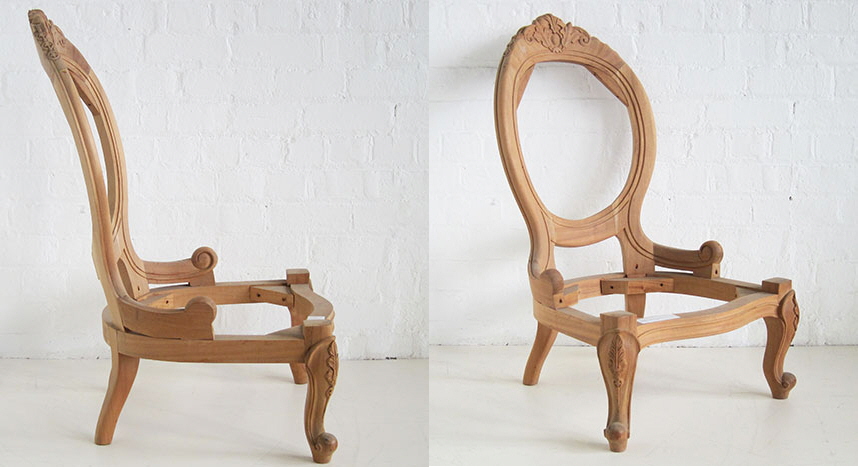
Understanding Furniture Design and Construction by Looking at Chair Skeletons
X-ray vision comes in handy here
 Enter a caption (optional)
Enter a caption (optional)Given a choice between having the superpowers of invisibility, flight or X-ray vision, designers should always choose X-ray vision. The ability to see how something is made, or observe the structure that's holding it all together, should appeal to us more than undetectable shoplifting. (And as I've already covered, with unassailable logic, being able to fly would suck.)
As an example, at left you see what Tom Dixon's wingback chair looks like. (Speaking of wingback chairs, here's why they have wings.) Some years ago Dixon had an exhibit where he showed you the chair in its various stages of construction. I always thought that was really cool because you could see exactly how they were made.
 Enter a caption (optional)
Enter a caption (optional) Enter a caption (optional)
Enter a caption (optional)You could learn a lot by looking at a classic piece of furniture like, say, Hans Wegner's Papa Bear chair…
 Enter a caption (optional)
Enter a caption (optional)…while your X-ray eyes allowed you to see the structure underneath:
 Enter a caption (optional)
Enter a caption (optional)Take a look at this chair from an article in Fine Woodworking. The legs look to be Cherry.
 Enter a caption (optional)
Enter a caption (optional)In a photo of the naked chair, they reveal that while the legs are indeed Cherry, the unseen frame of the chair is actually made from Maple and Poplar. This makes sense as Maple is strong and Poplar is easy to work. The Cherry is just the show wood.
 Enter a caption (optional)
Enter a caption (optional)There's a company called Dutch Connection in the UK that specializes in duplicating period furniture (Georgian, Regency, Chippendale, Victorian and French) in the original hand-carved method of manufacture, and supplying them to hotels, film productions and designers. On their website they've got a lot of photos of their chairs in the skeletal stage, allowing you to see where bracing has been applied, where the structures have been built up, etc.
 Enter a caption (optional)
Enter a caption (optional) Enter a caption (optional)
Enter a caption (optional) Enter a caption (optional)
Enter a caption (optional) Enter a caption (optional)
Enter a caption (optional) Enter a caption (optional)
Enter a caption (optional) Enter a caption (optional)
Enter a caption (optional)These are based on the designs of master craftsmen, and it's interesting to see just how little material they can get away with using, yet still make the chairs structural. Even if you don't care for the styles, if you're designing your own chair in a different style it may still help you to see where the old masters reckoned there ought to be support.
 Enter a caption (optional)
Enter a caption (optional) Enter a caption (optional)
Enter a caption (optional) Enter a caption (optional)
Enter a caption (optional) Enter a caption (optional)
Enter a caption (optional)Here's some terminology that might be helpful for communication, for example if you're designing the chair but someone else is building it. (Sorry for the lousy photo.)
 Enter a caption (optional)
Enter a caption (optional)Fully-upholstered furniture can be pretty impenetrable. For example, do any of you really know what the insides of a sofa or an easy chair look like?
 Enter a caption (optional)
Enter a caption (optional)Furniture manufacturer Holly Hunt has some cutaway images showing you what's inside their stuff. Their frames are Maple, not the plywood I was expecting.
 Enter a caption (optional)
Enter a caption (optional)While the photos above may not tell you much on their own, they've got an interactive on their site that reveals details of the construction.
 Enter a caption (optional)
Enter a caption (optional)In fact if you look around the web you can also find untraditional manufacturers touting their abilities by showing their furniture in skeletal form. For example, here's a custom sofa (clad in carbon fiber, for chrissakes) that UK-based digital fabricator The Cutting Room built from a client's Rhino3D file:
 Enter a caption (optional)
Enter a caption (optional) Enter a caption (optional)
Enter a caption (optional) Enter a caption (optional)
Enter a caption (optional) Enter a caption (optional)
Enter a caption (optional) Enter a caption (optional)
Enter a caption (optional)My only gripe with all of these photos is that they're so small. If I had X-ray vision I could walk into any showroom and see all of the details up close.
-
o5Favorite This
-
Q2Comment
K
{Welcome
Create a Core77 Account
Already have an account? Sign In
By creating a Core77 account you confirm that you accept the Terms of Use
K
Reset Password
Please enter your email and we will send an email to reset your password.


Comments
Great article, it is interesting to see the structure normally hidden under a good looking shell.
Rain: I love your articles! This article reminds me of a day in 1975, during my period of "designing without thinking" and "sideways thinking," that I challenged myself to draw a large number of chairs. I did not include "comfort" as a criteria, obviously. :) This two-page spread appears in my book, "Have Fun Inventing."